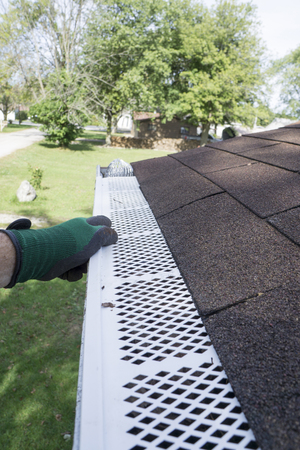When it comes to DIY gutter installation, tips you can use are many. Whether you have to install gutters on a larger home, or you require a more special installation, following the right instructions before getting to work can make the difference between a successful project and one that might just turn out to be a waste of time.
The tips below should help you prevent that and assist in laying the groundwork for your DIY gutter installation project without any unwanted aftereffects.
Measure and Purchase the Right Length of Gutters
 It’s important to attach rain gutters firmly to the fascia and have them run the whole length of the roof. Before setting to work on installing your gutters, or even purchasing them for that matter, it’s important to find out exactly how much you need.
It’s important to attach rain gutters firmly to the fascia and have them run the whole length of the roof. Before setting to work on installing your gutters, or even purchasing them for that matter, it’s important to find out exactly how much you need.
To determine that, simply measure the gutter run along the fascia, and for lengthier gutter runs, make sure you account for positioning them to pitch down from the center. Also, account for fascia brackets being placed at a distance of at most 32 inches from each other.
To conduct a proper measurement, first identify the highest point from which your gutter can run, and use a chalk to mark the start point and end point of your gutters. To calculate the precise slope of the gutter system, account for a downward inclination of .25 of an inch for every 10 feet of laid gutter material. The chalk line should go straight along the fascia, following the slope and ending at the determined end point (the lowest point where the fascia meets your new rain gutters). From there, determining and purchasing the correct length of gutters will be an easy task.
Types of Materials to Consider
When it comes to DIY gutter installation tips you can use, none are more important than those advising you of the types of gutter materials you can consider purchasing. The best approach is to determine what you need from your new gutters, and keep in mind the main advantages of each type of gutter material – not just in terms of price and durability, but also when it comes to ease of installation:
- Plastic can be easy to work with and light, its installation process not lasting too long. You can simply click its sections together, and it only requires some minor maintenance tasks.
- Aluminum is more robust and almost equally light. There are many different joining systems to choose from, and you can also prepare continuous gutters, if you have the skills and equipment.
- Cast iron is much harder and heavier, despite its traditional appeal. It also needs to be painted, and you’ll need to use nuts and bolts to set it into place.
- Finally, you can consider copper as a more durable installation. Despite its higher price, copper can be extremely attractive and efficient when used for gutters, and its lighter weight makes installing it a total breeze.
Before Mounting the Gutters
Before you mount your new gutters, you have to follow a few essential steps that require some technical skill. Cutting the gutters and attaching gutter brackets are the first, and they can be quite challenging.
Ultimately, the process will also require marking the right spot for the downspout, attaching the downspout connectors and mounting the gutters and downspout. You can get additional DIY gutter installation tips to help you with these tasks by contacting experienced roofers Fayetteville AR local contractors.


